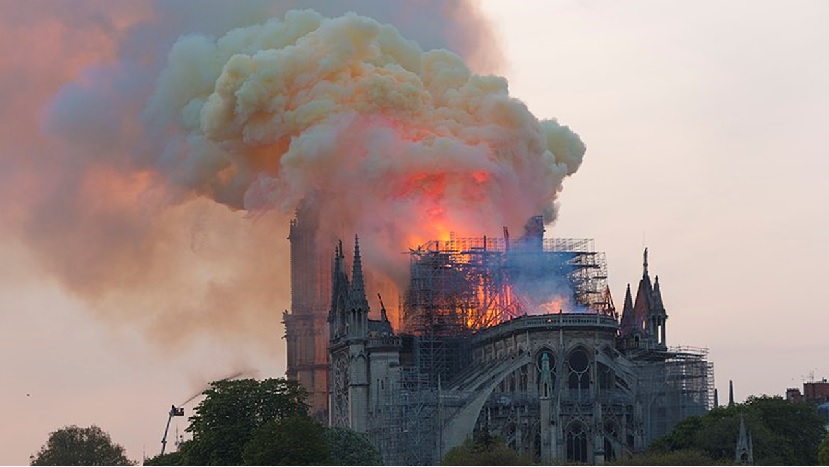“If your house were burning down and you could take away one thing, what would it be?”…”I’d take the fire.” — Jean Cocteau, interviewed by André Fraigneau
The images of the Notre-Dame de Paris Cathedral burning broke my heart.
I am grateful that people and organizations around the world have vowed to contribute to the restoration of this iconic symbol of France. Fortunately, no one died in the fire or while responding to the fire, and initial investigations indicate that beyond the roof itself, structural damage is limited. With the determination of so many, it is fair to hope that the cathedral’s restoration will take less than the century (1160 to 1260) that it originally took to build it.
The Notre-Dame has been altered and renovated many times. It’s good to know that the restored cathedral won’t be an exact replica of the original, or even an exact replica of the church as it was when it burned. Watching the fire rip through the structure makes me appreciate “taking the fire”, that is, modern fire suppression.
Not in 850 Years
It wasn’t that long ago (when we’re talking about centuries, decades seem just a blink of the eye) that a building constructed of stone was considered “fire proof.” Never mind the wooden timbers that supported the roof. Fire is a very patient teacher, however, and we’ve learned that nothing is “fire-proof.” Fire-resistant is the best we should ever hope for.
The Notre-Dame Cathedral has been through a lot. Attacks by Huguenots in the 16th century, attacks by French revolutionaries in the 18th century, attacks by neglect in the 19th century, and attacks during World War II in the 20th century. This fire, though, has been the most devastating. If one of the gargoyles could speak, I can imagine it at a hazard review, insisting, “I’ve seen riots, I’ve seen gunfire, but I’ve been here over 850 years, and I’ve never seen a fire. No, this building is fire-proof and a fire is just not credible.”
Now that it has happened, though, it clearly is credible. The speed at which the fire spread through the 12th century oak structure indicates that there were no fire suppression systems in place. I will be surprised if the rebuilt cathedral has a roof supported by oak timbers. Whether it does or not, I will be astonished if the building is not equipped with state-of-the-art fire suppression systems.
It Takes a Fire
A new building would have fire suppression already. Building codes in industrialized nations demand it. But we are partial to our “grandfather clauses” and consider existing buildings exempt from improvements in safety.
Obviously, no one wants to incur the cost of renovations. Retrofits are expensive, and for buildings of no great historical significance, the choice is often to knock them down and start over. For buildings of historical significance, though, in a time of limited resources (which is all the time), the choice sometimes comes down to either keeping the building, as unsafe as it was and still is, or lose the building. It’s a hard choice.
Somehow, though, the choice becomes much easier after a fire. The risk hasn’t changed. Just our willingness to do something about. Sometimes, it takes a fire.
Facility Siting
Grandfathered hazards are not limited to ancient structures of historical significance. In the process industries, there are thousands of facilities that were built decades ago, when we didn’t understand the need for spacing and emergency access, the need to avoid putting the control room in the very middle of the process, the need for buffer zones.
What do those facilities have in common?
Congested piping. Process equipment that requires the construction of scaffolding and bringing in cranes in order to perform routine maintenance, thus discouraging routine maintenance. Structures that cannot be reached by the spray from fire monitors, assuming there are fire monitors. Fire water supplies which were barely adequate when the plant was first built and now wholly inadequate after decades of expansions. Rail spurs that block access by first responders.
Yet it is a rare organization that will look at a situation like this and decide, “We need to raze the whole thing and build something that meets the best standards.” It’s cost prohibitive, we will all agree. It’s not until a disaster forces us to do something that we make the change. At which point, circumstances are controlling us, rather than us controlling the circumstances. Sometimes, though, it takes a fire.
Don’t Wait for the Fire
I have no idea what kind of discussions they had within the Archdiocese of Paris or within the French government about the need for fire suppression at the Notre-Dame de Paris Cathedral. I’m sure it came up and I’m equally sure that the term “coût prohibitif” came up. The real irony would be if the decision had already been made to do something to “take the fire,” but the work had been deferred.
Are there disasters waiting to happen at your facility, disasters that would prompt you to do things differently if they happened? Do those disasters have to happen before you do something about them?
Don’t wait for the fire. If the proposal is a bad idea now, before the disaster, it will still be a bad idea after the disaster. But if it is a good idea after a disaster, it’s a good idea now, and it will do more good now by preventing the disaster.
